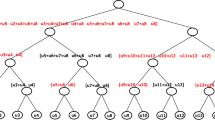Abstract
Digit serial architectures, which have digit serial data transmission combined with digit serial computation, are uniquely suited for the design of VLSI signal processors. The speed disadvantages of digit serial input are overcome if the input is overlapped with the computation—what we refer to as digit pipelining. Digit pipelining allows us to break up long strings of combinatorial logic and, thus, to increase the clock rate of the system while still preserving much of the circuit structure. In general, for a modest increase in hardware (which in VLSI translates to a modest increase in area) digit serial architectures offer the potential of higher throughput than equivalent word parallel architectures. Several designs for various digit serial adders are presented. Then two filter examples are discussed that use the digit serial adders to achieve digit pipelining.
Similar content being viewed by others
References
R. Lyons, “A bit-serial VLSI architectural methodology for signal processing,”VLSI'81, Ed. J.P. Gray. New York: Academic Press, 1981, pp. 131–140.
P. Denyer and D. Renshaw,VLSI Signal Processing: A Bit-Serial Approach, Reading, MA: Addison-Wesley, 1985.
M.J. Irwin and R.M. Owens, “Digit pipelined arithmetic: A tutorial,”IEEE Computer Magazine, April 1987, pp. 61–73.
S.G. Smith and P.B. Denyer,Serial-Data Computation, Kluwer Academic Publishers, 1988.
S. Knowleset al., “Bit-level systolic arrays for IIR filtering,”Proc. of the Intl. Conf. on Systolic Arrays, San Diego, CA, May 1988, pp. 653–663.
R. Hartley and P. Corbett, “A digit-serial silicon compiler,”Proc. of DAC'88, Anaheim, CA, June 1988, pp. 646–649.
S.G. Smith and P.B. Denyer, “Advanced serial-data computation,”Journal of Parallel and Distributed Computing, June 1988.
R. Woods,et al., “Systolic IIR filters with bit-level pipelining,”Proc. of ICASSP'88, March 1988, pp. 2072–2075.
M.J. Irwin and R.M. Owens, “A comparison of two digit serial VLSI adders,”Proc. ICCD, Rye Brook, NY, Oct. 1988, pp. 227–229.
G. Metze and J. Robertson, “Elimination of carry propagation in digital computers,”Proc. International Conf. on Information Processing, Paris, France, June 1959.
A. Avizenis, “Signed-digit number representations for fast parallel arithmetic,”IRE Trans. Electronic Computers, vol. EC-10, 1961, pp. 389–400.
G. Metze,A Study of Parallel One's Complement Arithmetic Units with Separate Carry or Borrow Storage, Ph.D. Thesis, Report No. 8, Digital Computer Laboratory, University of Illinois, Nov. 1957.
J. Robertson, “A theory of decomposition of structures for binary addition and subtraction,” UIUCDCS-R-80-1004, Dept. of Computer Science, Univ. of Illinois, Jan. 1981.
M. Andrews, “A systolic SBNR adaptive signal processor,”IEEE Trans. Circuits and Systems, vol. CAS-33, 1986, pp. 230–238.
T. Carter, “Structured arithmetic tiling of integrated circuits,”Proc. of 8th Symp. on Computer Arithmetic, Como, Italy, May 1987, pp. 41–48.
S. Kuninobu,et al., “Design of high-speed MOS multiplier and divider using redundant binary representation,”Proc. of 8th Symp. on Computer Arithmetic, Como, Italy, May 1987, pp. 80–86.
J. Beekman, R.M. Owens, and M.J. Irwin, “Mesh arrays and LOGICIAN: A tool for their efficient generation,”Proc. of DAC '87, July 1987, pp. 357–363.
H.T. Kung and C. Leiserson, “Systolic arrays (for VLSI),”Sparse Matrix Proceedings, SIAM, 1979, pp. 256–282.
C. Leiserson and J. Saxe, “Optimizing synchronous systems,” CMU-CS-82-101, Dept. Computer Science, Carnegie-Mellon Univ., 1982.
C. Leiserson, R. Rose and J. Saxe, “Optimizing synchronous circuitry by retiming,”Third Caltech Conf. on VLSI, Ed. R. Bryant: Pasadena: Computer Science Press, 1983.
R.M. Owens and M.J. Irwin, “Being stingy with multipliers,” CS-87-33, Dept. of Computer Science, Penn State University, Nov. 1987. To appear inIEEE Trans. Computers.
M.J. Irwin and D. Heller, “Online pipelined systems for recursive numeric computation,”Proc. of 7th Inter. Symp. on Computer Architecture, France, May 1980, pp. 292–299.
K.K. Parhi and D. Messerschmitt, “Look-ahead computation: Improving interation bounds in linear recursions,”Proc. of ASSP, Dallas, 1987, pp. 42.18.4–4.
R.M. Owens, and M.J. Irwin, “The arithmetic cube,”IEEE Trans. Computers, 1987, pp. 1342–1348.
M.J. Irwin, “A digit pipelined dynamic time warp processor,”IEEE Trans. ASSP, vol. 36, 1988, pp. 1412–1422.
C-M Wu, R.M. Owens, and M.J. Irwin, “A space warp VLSI processor,” InVLSI Signal Processing, III, Ed., R.W. Broderson, Monterey: IEEE Press, 1988.
R.M. Owens and M.J. Irwin, “An overview of the Penn State design system,”Proc. of DAC'87, July 1987, pp. 516–522.
M.J. Irwin and R.M. Owens, “A VLSI design system for signal processors,” InVLSI Signal Processing, III Ed. R.W. Broderson, Monterey: IEEE Press, 1988, pp. 283–294.
Author information
Authors and Affiliations
Rights and permissions
About this article
Cite this article
Irwin, M.J., Owens, R.M. A case for digit serial VLSI signal processors. J VLSI Sign Process Syst Sign Image Video Technol 1, 321–334 (1990). https://doi.org/10.1007/BF00929925
Received:
Revised:
Published:
Issue Date:
DOI: https://doi.org/10.1007/BF00929925




